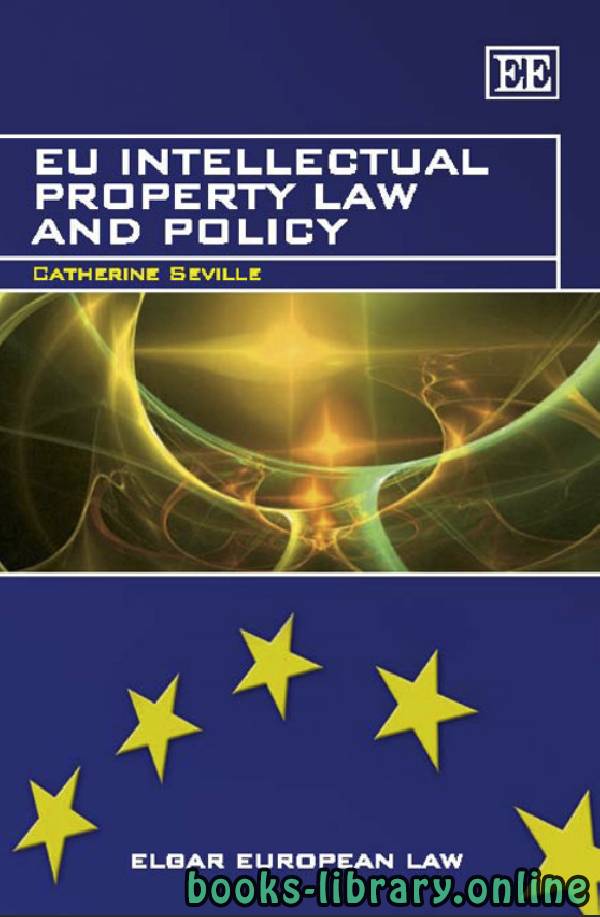📘 قراءة كتاب EU Intellectual Property Law and Policy أونلاين


1 Introduction 1
2 Copyright and related rights 7
2.1 Introduction 7
2.2 International conventions 8
2.2.1 Early bilateral agreements 8
2.2.2 The Berne Convention 9
2.2.3 The Universal Copyright Convention 13
2.2.4 The Rome Convention 14
2.2.5 TRIPS 17
2.2.6 The WIPO Internet Treaties 19
2.3 The influence of the European Union 23
2.3.1 An early survey: the Commission’s 1988 Green
Paper 24
2.3.2 The Computer Programs Directive 27
2.3.3 The Rental Directive 29
2.3.4 The Satellite and Cable Directive 34
2.3.5 The Term Directive 38
2.3.6 The Database Directive 41
2.3.7 The E-Commerce Directive 47
2.3.8 The Information Society Directive 49
2.3.9 The Resale Right Directive 57
2.3.10 Future Reforms 61
3 Patents and related rights 69
3.1 Introduction 69
3.2 The global patent environment 74
3.2.1 The Paris Convention 74
3.2.2 The Patent Cooperation Treaty 75
3.2.3 TRIPS 77
vii
3.2.4 The Convention on Biological Diversity (CBD) 85
3.2.5 The Patent Law Treaty 88
3.3 The European patent environment 91
3.3.1 The European Patent Convention 91
3.3.1.1 History 91
3.3.1.2 EPC 2000 – major changes 92
3.3.1.3 EPC 2000: overview and procedure 94
3.3.1.4 Opposition proceedings 100
3.3.1.5 Substantive harmonisation – limits and
definitional challenges 101
3.3.1.6 Article 69 – interpretation of claims 102
3.3.1.7 European patent – substantive
requirements 104
(1) Novelty – Article 54 105
(2) Inventive step – Article 56 111
(3) Industrial application – Article 57 117
(4) Excluded subject matter –
Article 52(2)–Article 53 118
(i) The boundary between discoveries
and inventions 120
(ii) Computer-related inventions 122
(iii) Biological subject matter –
Article 53(b) 127
(iv) Methods for treatment of the
human or animal body –
Article 53(c) 132
(v) Morality – Article 53(a) 133
(5) Sufficiency of disclosure 141
3.3.2 Other legislative initiatives in European patent law –
the London Agreement and the EPLA 142
3.3.2.1 The London Agreement 143
3.3.2.2 The European Patent Litigation Agreement
(EPLA) 144
3.3.3 Community initiatives in the field of patent law 148
3.3.3.1 The Community patent: context and
history 148
3.3.3.2 Supplementary protection certificates 158
3.3.3.3 The Biotechnology Directive: the legal
protection of biotechnological inventions 159
3.3.3.4 Utility models 169
3.4 Plant variety rights 170
3.4.1 History of protection 170
viii EU intellectual property law and policy
3.4.2 The UPOV Convention 172
3.4.3 The Community plant variety right 174
4 Designs 180
4.1 Introduction – the concept of design 180
4.2 First steps towards EC harmonisation 181
4.3 Registered Community Design 184
4.4 The Community definition of ‘design’ 189
4.5 Grounds of invalidity 192
4.5.1 Novelty 193
4.5.2 Individual character 195
4.5.3 Complex products – special requirements 196
4.5.4 Relative grounds of invalidity 197
4.6 The design proprietor’s rights 200
4.6.1 Initial entitlement 200
4.6.2 Assignment and licences 201
4.6.3 Duration 202
4.6.4 Rights conferred by the design right 203
4.6.5 Exceptions and defences 205
5 Trade marks and related rights 210
5.1 Introduction 210
5.2 Treaties administered by WIPO 213
5.2.1 The Paris Convention 213
5.2.2 The Madrid Agreement 214
5.2.3 The Madrid Protocol 216
5.2.4 The Trademark Law Treaty 218
5.2.5 The Singapore Treaty on the Law of Trademarks 219
5.3 TRIPS 219
5.4 Community trade mark legislation 220
5.4.1 Overview 220
5.4.2 Applying for a Community trade mark 222
5.4.3 Criteria for registration 224
(a) What is a registrable mark? 225
(b) The absolute grounds for refusal 233
(i) Signs which do not conform to the
requirements of a trade mark 233
(ii) ‘Devoid of any distinctive character’ 233
(iii) Descriptive marks 239
(iv) Customary and generic marks 242
(v) Acquired distinctiveness 243
(vi) The shape exclusions 245
Contents ix
(vii) The remaining absolute grounds for
refusal 249
(i) Public policy and morality 249
(ii) Deceptive marks 251
(iii) Special emblems and marks
prohibited by law 252
(iv) Bad faith 253
(c) Relative grounds for refusal 253
1 Earlier trade marks 254
(i) Identical trade mark and identical
goods 254
(ii) Confusingly similar marks and goods 255
(iii) Marks with a reputation 263
2 Earlier rights (non-trade mark) 268
5.4.4 Cancellation of a mark 269
5.4.5 Infringement 274
5.4.6 Defences 279
5.4.7 Other EU harmonisation initiatives relevant to
trade marks 283
(a) Misleading advertising 283
(b) Unfair Commercial Practices Directive 286
(c) Domain names 287
5.4.8 Community trade marks as objects of property 288
5.5 Geographical indications of origin 290
5.5.1 Introduction 290
5.5.2 International treaties 290
5.5.3 TRIPS 292
5.5.4 The EU regime 294
5.5.5 Traditional specialities guaranteed 305
6 Intellectual property and free movement of goods 310
6.1 Introduction 310
6.1.1 Overview of the problem – three typical cases 310
6.1.2 Intellectual property rights – different rights
have different purposes 317
6.2 Intellectual property in the Community – the free
movement of goods 319
6.2.1 The treaty: the basic legal framework 319
6.2.2 Early case law: the distinction between existence
and exercise of rights 320
6.2.3 Specific subject matter: definitions 322
x EU intellectual property law and policy
6.2.4 What is ‘consent’ for the purposes of exhaustion
of rights? 327
6.3 Repackaging: balancing the principle of free movement
against the trade mark owner’s rights 337
6.3.1 Pharmaceuticals 337
6.3.2 Repackaging principles – application to other
products? 350
6.4 Use of another’s trade mark in advertising 351
6.5 Goods in transit are not ‘on the market’ 356
6.6 Exhaustion: national, Community-wide or international? 359
6.7 Competition law and intellectual property 373
6.7.1 Article 81 374
Assignments 375
Licensing agreements 376
Copyright licensing – individual and collective 378
Unilateral action and Article 81(1) 382
Dual pricing 383
Block exemptions – the Technology Transfer
Regulation 386
6.7.2 Article 82 391
7 Enforcement of intellectual property rights 404
7.1 TRIPS 404
7.2 European Community measures 407
7.2.1 The Enforcement Directive 408
7.2.2 The Draft Criminal Enforcement Directive 412
7.2.3 Counterfeiting: future measures 416
7.2.4 Jurisdiction – the Brussels Regulation
2 حق المؤلف والحقوق المجاورة 7
2.1 مقدمة 7
2.2 الاتفاقيات الدولية
2.2.1 الاتفاقيات الثنائية المبكرة 8
2.2.2 اتفاقية برن 9
2.2.3 الاتفاقية العالمية لحق المؤلف
2.2.4 اتفاقية روما 14
2.2.5 تريبس 17
2.2.6 معاهدات الويبو على الإنترنت 19
2.3 تأثير الاتحاد الأوروبي 23
2.3.1 دراسة استقصائية مبكرة: اللجنة الخضراء لعام 1988
ورقة 24
2.3.2 توجيه برامج الكمبيوتر 27
2.3.3 توجيه التأجير 29
2.3.4 توجيه القمر الصناعي والكابل 34
2.3.5 البند التوجيه 38
2.3.6 قاعدة بيانات التوجيه 41
2.3.7 توجيه التجارة الإلكترونية 47
2.3.8 توجيه مجتمع المعلومات 49
2.3.9 التوجيه الصحيح لإعادة البيع 57
2.3.10 الإصلاحات المستقبلية 61
3 براءات الاختراع والحقوق المجاورة 69
3.1 مقدمة 69
3.2 بيئة براءات الاختراع العالمية 74
3.2.1 اتفاقية باريس 74
3.2.2 معاهدة التعاون بشأن البراءات
3.2.3 تريبس 77
السابع
3.2.4 اتفاقية التنوع البيولوجي (CBD)
3.2.5 معاهدة قانون البراءات 88
3.3 بيئة براءات الاختراع الأوروبية 91
3.3.1 الاتفاقية الأوروبية للبراءات 91
3.3.1.1 التاريخ 91
3.3.1.2 EPC 2000 - تغييرات رئيسية 92
3.3.1.3 EPC 2000: نظرة عامة وإجراء 94
3.3.1.4 إجراءات المعارضة 100
3.3.1.5 التنسيق الموضوعي - الحدود و
التحديات التعريفية 101
3.3.1.6 المادة 69 - تفسير المطالبات 102
3.3.1.7 براءة اختراع أوروبية - موضوعية
متطلبات 104
(1) الجدة - المادة 54 105
(2) الخطوة الابتكارية - المادة 56 111
(3) التطبيق الصناعي - المادة 57 117
(4) موضوع مستبعد -
المادة 52 (2) - المادة 53 118
(ط) الحدود بين الاكتشافات
والاختراعات 120
(2) الاختراعات المتعلقة بالحاسوب 122
(3) الموضوع البيولوجي -
المادة 53 (ب) 127
(رابعا) طرق لعلاج
جسم بشري أو حيواني -
المادة 53 (ج) 132
(5) الأخلاق - المادة 53 (أ) 133
(5) كفاية الكشف 141
3.3.2 المبادرات التشريعية الأخرى في قانون البراءات الأوروبي -
اتفاقية لندن و EPLA 142
3.3.2.1 اتفاقية لندن 143
3.3.2.2 اتفاقية التقاضي بشأن البراءات الأوروبية
(EPLA) 144
3.3.3 مبادرات المجتمع في مجال قانون البراءات 148
3.3.3.1 براءة اختراع المجتمع: السياق و
التاريخ 148
3.3.3.2 شهادات الحماية التكميلية 158
3.3.3.3 توجيه التكنولوجيا الحيوية: القانوني
حماية الاختراعات التكنولوجية الحيوية
3.3.3.4 نماذج المنفعة 169
3.4 حقوق الأصناف النباتية
3.4.1 تاريخ الحماية 170
ثامنا قانون وسياسة الملكية الفكرية للاتحاد الأوروبي
3.4.2 اتفاقية UPOV 172
3.4.3 الصنف النباتي المجتمعي الصحيح 174
4 تصاميم 180
4.1 مقدمة - مفهوم التصميم 180
2.4 الخطوات الأولى نحو تنسيق الاتحاد الأوروبي 181
4.3 تصميم المجتمع المسجل 184
4.4 تعريف المجتمع لـ "التصميم" 189
4.5 أسباب البطل 192
4.5.1 الجدة 193
4.5.2 شخصية فردية 195
4.5.3 المنتجات المعقدة - المتطلبات الخاصة 196
4.5.4 الأسباب النسبية للبطلان 197
4.6 حقوق مالك التصميم 200
4.6.1 الاستحقاق الأولي 200
4.6.2 التنازل والتراخيص 201
4.6.3 المدة 202
4.6.4 الحقوق الممنوحة بموجب حق التصميم 203
4.6.5 الاستثناءات والدفوع 205
5 العلامات التجارية والحقوق المجاورة 210
5.1 مقدمة 210
5.2 المعاهدات التي تديرها الويبو 213
5.2.1 اتفاقية باريس 213
5.2.2 اتفاقية مدريد 214
5.2.3 بروتوكول مدريد 216
5.2.4 معاهدة قانون العلامات التجارية 218
5.2.5 معاهدة سنغافورة بشأن قانون العلامات التجارية 219
5.3 تريبس 219
5.4 تشريع العلامات التجارية المجتمعية 220
5.4.1 نظرة عامة 220
5.4.2 التقديم للعلامة التجارية المجتمعية 222
5.4.3 معايير التسجيل 224
(أ) ما هي العلامة القابلة للتسجيل؟ 225
(ب) الأسباب المطلقة للرفض 233
(ط) علامات لا تتفق مع
متطلبات العلامة التجارية 233
(2) "خالية من أي شخصية مميزة" 233
(3) العلامات الوصفية 239
(4) العلامات العرفية والعامة 242
(ت) الحصول على التميز 243
(السادس) الشكل استثناءات 245
محتويات التاسع
(7) الأسباب المطلقة المتبقية
رفض 249
(ط) السياسة العامة والأخلاق 249
(2) علامات الخداع 251
(3) الشعارات والعلامات الخاصة
محظور بموجب القانون 252
(د) سوء النية 253
(ج) الأسباب النسبية للرفض 253
1 العلامات التجارية السابقة 254
(ط) العلامة التجارية المتطابقة والمطابقة
البضائع 254
ii 2 and علامات وسلع مماثلة متشابكة 255
(ج) علامات بسمعة 263
2 الحقوق السابقة (غير علامة تجارية) 268
5.4.4 إلغاء علامة 269
5.4.5 الانتهاك 274
5.4.6 الدفاعات 279
5.4.7 مبادرات التنسيق الأخرى للاتحاد الأوروبي ذات الصلة
العلامات التجارية 283
(أ) الدعاية المضللة 283
(ب) توجيه الممارسات التجارية غير العادلة 286
(ج) أسماء النطاقات 287
5.4.8 العلامات التجارية للمجتمع ككائنات للملكية 288
5.5 المؤشرات الجغرافية للمنشأ 290
5.5.1 مقدمة 290
5.5.2 المعاهدات الدولية 290
5.5.3 تريبس 292
5.5.4 نظام الاتحاد الأوروبي 294
5.5.5 التخصصات التقليدية مضمونة 305
6 الملكية الفكرية وحرية حركة البضائع 310
6.1 مقدمة 310
6.1.1 نظرة عامة على المشكلة - ثلاث حالات نموذجية 310
6.1.2 حقوق الملكية الفكرية - حقوق مختلفة
لها أغراض مختلفة 317
6.2 الملكية الفكرية في المجتمع - مجانية
حركة البضائع 319
6.2.1 المعاهدة
سنة النشر : 2009م / 1430هـ .
نوع الكتاب : pdf.
عداد القراءة:
اذا اعجبك الكتاب فضلاً اضغط على أعجبني و يمكنك تحميله من هنا:

شكرًا لمساهمتكم
شكراً لمساهمتكم معنا في الإرتقاء بمستوى المكتبة ، يمكنكم االتبليغ عن اخطاء او سوء اختيار للكتب وتصنيفها ومحتواها ، أو كتاب يُمنع نشره ، او محمي بحقوق طبع ونشر ، فضلاً قم بالتبليغ عن الكتاب المُخالف:
 قبل تحميل الكتاب ..
قبل تحميل الكتاب ..
يجب ان يتوفر لديكم برنامج تشغيل وقراءة ملفات pdf
يمكن تحميلة من هنا 'http://get.adobe.com/reader/'


 منصّة المكتبة
منصّة المكتبة 